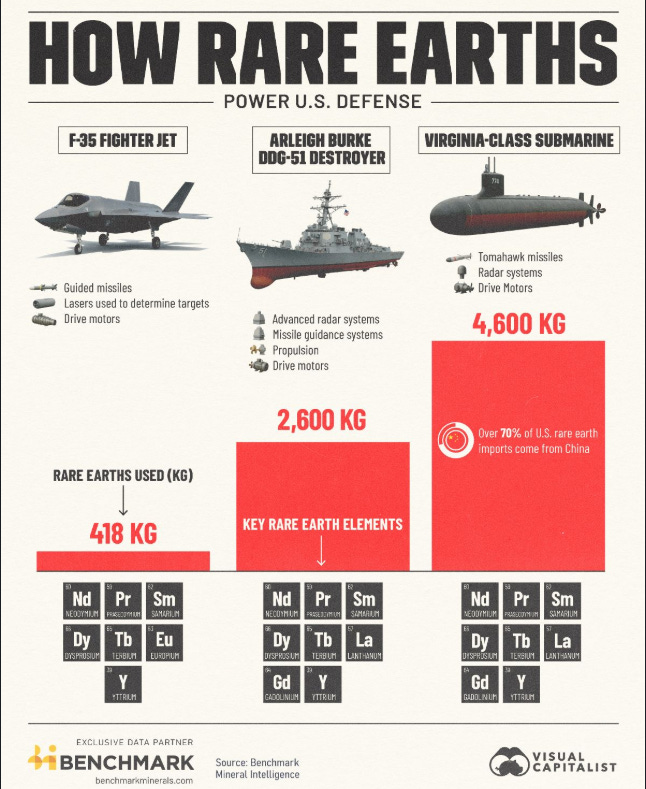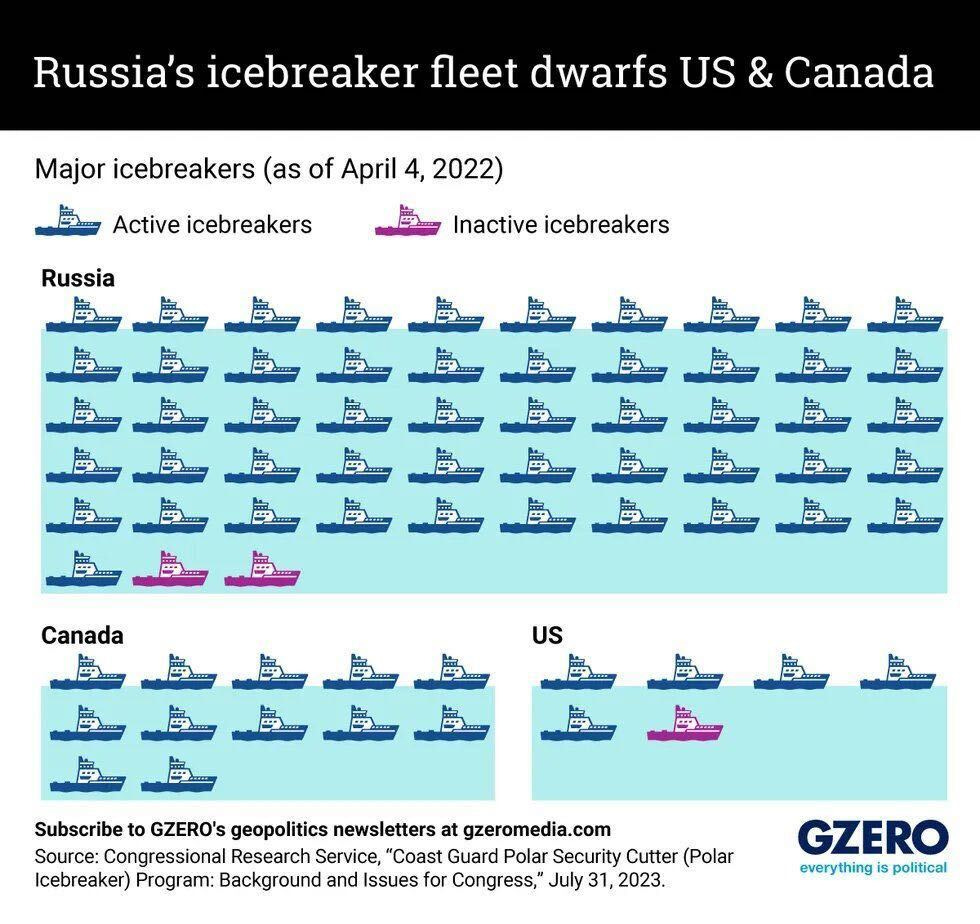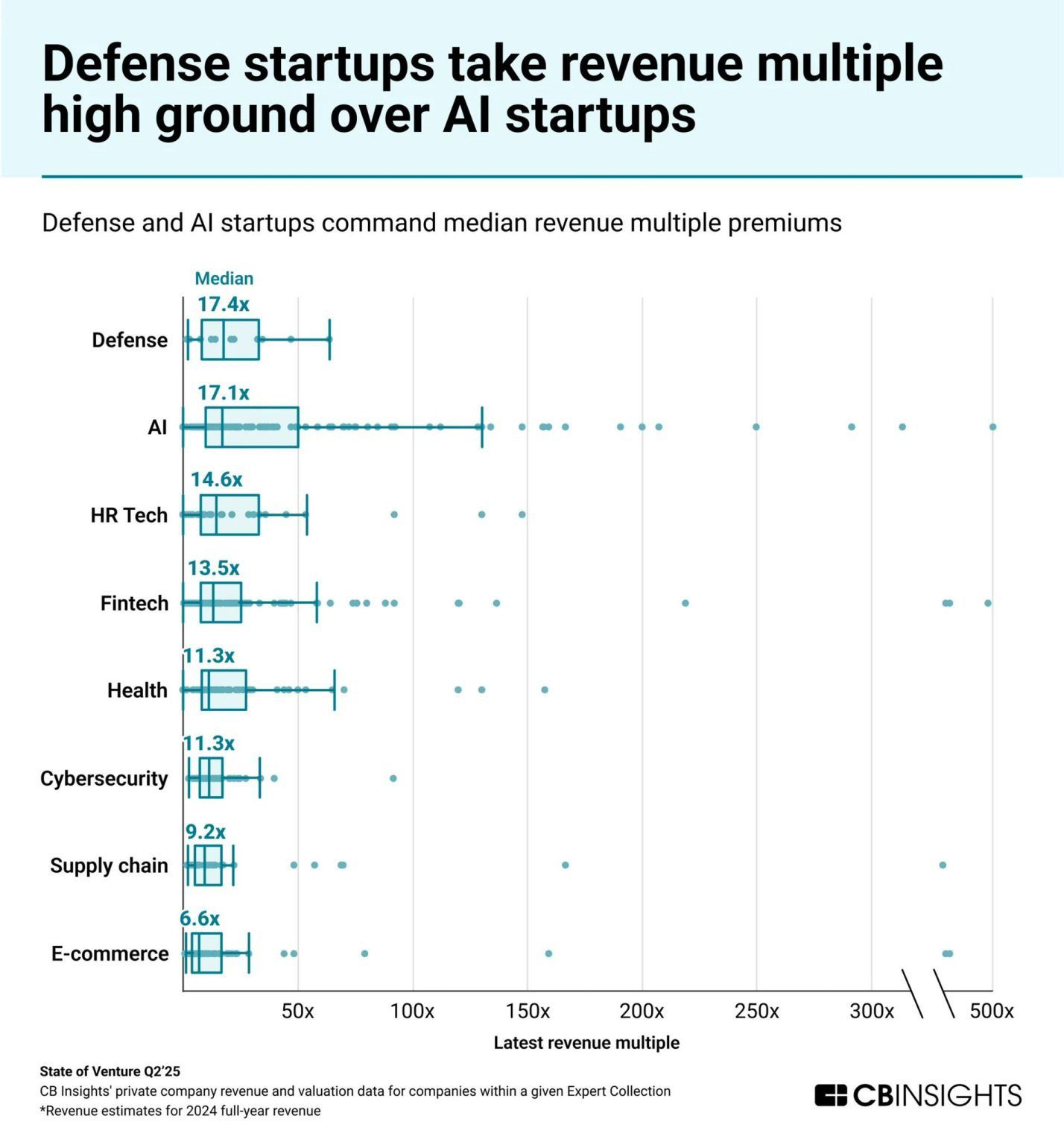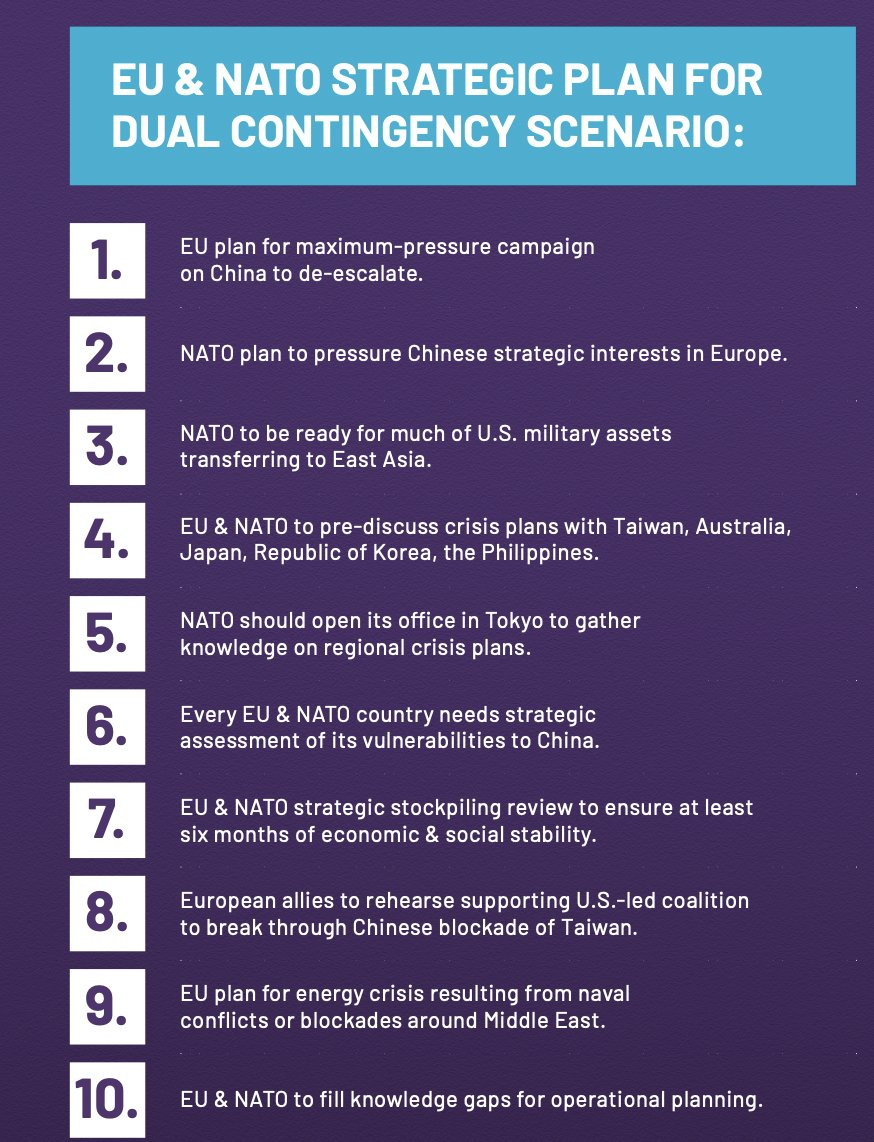Canada’s Security Begins in the Quarry
Rare-Earth Minerals Gap Undermines Canada’s Sovereign Capability
🎯 Three-Shot Burst
Modern defence systems are powered by critical materials called rare-earth minerals — natural materials containing rare earth elements, a group of 17 metallic elements with unique properties. While they are not exceptionally rare in the Earth's crust, they are often dispersed and difficult to extract in economically viable concentrations. They are crucial for defence technologies such as radar, propulsion systems, and missile guidance.
An F-35 uses over 400 kg of rare-earths. A Virginia-class submarine? Over 4600 kg.
Yet more than 70% of US rare earth imports come from countries outside of NATO. In the case of Europe this percentage is even higher.
Reality check: As defence becomes more tech-driven, securing these raw materials becomes a strategic necessity for any nation aiming to maintain operational readiness and control. The kit that protects Canadian sovereignty depends on supply lines we don’t control and rivals can halt: China is actively choking the supply of critical minerals to Western defence companies.
However, a new assessment of which jurisdictions are best positioned to emerge as commercially competitive rare-earth processing hubs names Canada as a top contender.
Bottom line: OEMs and senior defence stakeholders will admit privately that supply chain risks about material sourcing continue to be a part of our conversation as a core concern. Strengthening visibility and investing in local and allied sourcing strategies must become part of the solution. Top CEO’s want Canada to build a strategic minerals reserve for defence, while PM Carney has indicated that Canada plans to leverage its critical mineral wealth as part of our military contribution to NATO.
Canada’s arsenal is only as strong as the rocks we can actually get our hands on, and right now, the functioning quarries are in somebody else’s backyard.
Related:
Not so fast? The complexities and fragilities of successful societies, and how specialization can lead to higher living standards but also increased vulnerability such as a hollowed out, outsourced manufacturing and processing capability:
How Canada can become a nuclear superpower: The CANDU reactor, a 70-year-old Canadian technology, is our ace in the hole
Mining the Arctic: The combination of geopolitics, resource extraction, and rapidly warming temperatures mean that this region is likely to have a dramatic effect on our economic and defence security in the coming years… Canada’s renewed focus on Arctic security has led to lots of comparisons with Russia’s Arctic posture - usually to Canada’s disadvantage.
1970s redux - AI drives the next great energy dislocation: China produces 60% of the world's electric vehicles and adds more solar capacity each year than the US has installed to date. Meanwhile, America remains fixated on AI software rather than the electricity needed to power it. This represents a fundamental shift in how energy shapes geopolitical power. For centuries, nations gained advantage by controlling territory rich in coal or oil. Today, that geographic link between energy and power faces its deepest disruption since medieval windmills freed settlements from river valleys
📋 Deal Corner
Beyond Aerospace is focused on private 5G networks, and has developed a dual-use blockchain-based cyber architecture to address network and data security.
The company has proven its Ares data platform with DND and DoD customers and is applying it to private 5G networks. A decentralized security overlay, Ares addresses security vulnerabilities unique to defence and critical industries, while leveraging the underlying 5G network infrastructure to deliver secure edge compute services.
The Kelowna-based software company has been awarded several Canadian DND and US DoD contracts, has been bootstrapped to date, and is seeking $8M in Series A funding to scale into commercial markets.
Reply to this email to be put in touch with CEO Mike Ball.
💾 Canada’s first Defence Tech Hackathon
September 20 in Toronto at the DMZ
The Defence Tech Hackathon is a catalyst to jumpstart a world-class ecosystem that builds sovereign capability in Canada. Our goal is to attract top talent, rapidly prototype real-world solutions, and bridge the gap between innovators and military end-users.
By forging new startups, building critical networks, and injecting a sense of urgency into defence innovation, this hackathon lays the foundation for Canada to compete and win on the global stage. We aim to advance the grassroots spirit of current and soon-to-be defence tech entrepreneurs.
We are still finalizing details, but here is what we know so far:
We will aim to rapidly prototype dual-use tech that solves real operational gaps for the Canadian Armed Forces
We are considering a challenge for a prototype platform that ingests multi-modal sensor feeds (satellite, UAV, radar, acoustic, etc.) and fuses them for real-time Arctic domain awareness
If you’re a software engineer who is defence-curious, this could be for you. We are looking for folks with domain expertise/experience in one or more of: defence, dual use tech (software and technology that can be used for both civilian and military applications), or Arctic operations; or who have any prior experience with multi-modal sensor fusion and real-time data platforms
🤝 Euro Trip
Spot of tea: Why are many of the buzziest foreign defence tech startups — from Anduril to Helsing — laying roots in the UK right now?
Cash up: Europe's defence tech sector is experiencing unprecedented growth, with funding already hitting €1.2bn in 2025 - nearly matching all of 2024's €1.7bn total
An American in Paris: Deeptech VC Michael Jackson on why European AI companies are bringing a knife to a gun fight
Hey Siri!: Ex-Apple engineer brings Silicon Valley tactics to European defence tech, mimicking vertically integrated approach taken by Tesla and Apple at Delian Alliance Industries
La Dolce Vita: Are you a Canadian aerospace or security company interested in Italy? Applications are now open for the Canada Trade Mission to Italy, happening October 12–17, 2025, with a focus on defence, security and aerospace
The Enshittification of American Power: First Google and Facebook, then the world. Under Trump 2.0, US statecraft is starting to mimic the worst tendencies of Big Tech
European eVTOL researcher seeks co-founders for novel UAV… Defence tech valuations are soaring:
Our partners at the European Defense Tech Hub are hosting a hackathon in Copenhagen later this month focused on detecting drones in real time using acoustic signals.
⚔️ Combat Readiness
Fighting on two fronts
Multiple sources indicate a growing concern among NATO and US military leadership regarding the possibility of a coordinated or simultaneous escalation by Russia and China in Europe and East Asia, potentially as early as 2027.
The European Values Center for Security Policy has simulated such contingency with 40+ allied governmental officials and experts across NATO and Indo-Pacific democracies.
It is likely the most unclassified detailed contingency analysis focusing on actions of individual states so far.
Related:
Ukraine has become the largest drone and defence tech lab in the world, and the country now relies upon up to 5 million drones per year. How will opening up exports affect the country’s UAV manufacturers?
Ukrainian soldier escapes on e-bike delivered by drone
Critical weapons development lessons from Ukraine are not being learned by the West
Palantir gets $10 billion contract from U.S. Army — one of the largest DoD contracts ever
Drones and the future of warfare:
A long read summarizing major developments in Russia’s defence production, cooperation, and innovations throughout July. The doubling of gunpowder production, efforts to educate schoolchildren about drones, and an expanding missile arsenal that Russia is reportedly stockpiling…
🍁 Canada’s Inaugural Defence Power 50 List
Until August 11, we are taking nominations for Canada’s inaugural Defence Power 50 List. The list will recognize the most influential leaders and up-and-comers in the defence community who are critical to making the changes Canada needs.
The selection of this inaugural 2025 list is co-chaired by Erin O'Toole, Glenn Cowan, Philippe Lagassé, Sheldon McCormick, and Eliot Pence.
Nominate someone we should know about today!
🔫 Hot Shots
Space race: This was supposed to be the year China started catching up with SpaceX… Our friends at Build Canada want us to use industrial policy to claim Canada's place in space… Neil Woodcock (Polaris Aerospace) on this topic at the 2025 Canadian Space Launch Conference:
Rush order: PM Carney wants to spend an extra $9B on defence by April. Is that possible?… The Cyclone helicopter saga offers a painful reminder of what happens when procurement decisions prioritize optics over operational outcomes
You’re doing it wrong: Germany prepares huge orders for jets, armoured vehicles, sources say… They likely ought to review modern capability requirements first
Tired from all the winning: Ottawa-based Mission Control has been awarded a $4.7M contract from the Canadian Space Agency to design and develop Canada’s next major space mission — the Canadian Lunar Utility Rover… BC-based 4AG Robotics has closed a $40M CAD Series B to ramp manufacturing, scale globally, and back the farms shaping the future of food… MDA Space wins $1.8-billion contract to build satellites for new EchoStar network… Ottawa’s Versaterm buys Austin-based drone tech company for more than $100-million
Sanctions: Canada must sanction the Chinese tech companies fuelling the horrors in Ukraine… Is China a better trading partner than Trump’s America?
Trade by threat: America's tariff gambit and Canada's moment of decision
From Russia with Love: Investor, businessman, and author Michael Calvey walks through what it was like to be an early tech investor in Russia and later becoming a prisoner of the state
Bond, James Bond: Britain’s spies-for-hire are running wild
Venture backed: Meet the CIA-backed venture fund behind Palantir, Anduril—and a spy tool that might be on your phone… Top corporate venture capital arms focused on defence and security… Today’s Silicon Valley had its start in government secrecy and wartime urgency:
…Steve Blank does a good job with the history. But everyone knows the modern secret sauce in Silicon Valley is actually a bunch of Canucks:
Public safety: Public Safety Minister in potential conflict of interest over planned ‘bubble zone’ protests bill… Wife of terror group ‘member’ backed by public safety minister does not live in his riding… Top army commander says 'completely unacceptable' behaviour is eroding trust in the Canadian Forces
Bits and bytes: Canadian companies racing to build sovereign, energy efficient data centres… How US, Canada are advancing military autonomous systems… How can we innovate if Canada does not properly protect intellectual property?… Canada’s tactical awakening
Shoo-in: Vancouver shoe-scanning company vies to speed up airport security screening
Penny for your thoughts: The roots of the IDEaS program, and the five funding elements that are currently available to innovators… DRDC announces IDEaS NORAD Modernization recipients, including several startups!… CGAI and COVE are partnering and inviting applications to a Defence Innovation Fellowship program. The selected researcher is to study the Canadian dual-use and defence technology ecosystem [Editor’s note: Just start a company instead!]
🤝 Meet the Defence Tech Community
The Icebreaker is hosting another meetup, this time on the West Coast
Defence Tech Patio Drop In, August 14 in Victoria, B.C.: Sign up here to join VCs, founders, operators, defence primes, and the defence-curious, over a few cold beers on a sunny patio.
If you’ve got battlefield intel, classified tips, or just want to call in an airstrike on our typos, hit “reply” and sound off. Whether it’s a new tech sighting, a rumour from the mess hall, or feedback on our comms, we want your SITREP.










